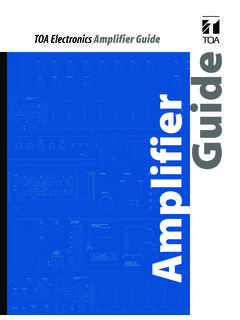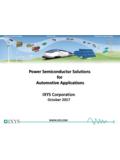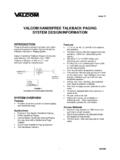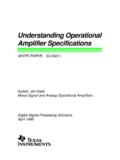Transcription of TOA Speaker Guide - toacanada.com
1 ElectronicsSpeaker GuideTOA Electronics Speaker Guide vTable of ContentsList of viiiChapter 1: Getting Started: System design 2: System ..12 Speech Reinforcement ..12 Background Music ..13 Foreground Music ..13 Voice/Music Combinations ..13 Presentation Audio ..13 Chapter 3: Speaker Speakers ..14 Wall-mount Speakers ..14In-wall ..16 Chapter 4: Audio Decibel ..17 Sound Pressure , Volume, and Ratings and the Decibel ..18 Attenuation over Distance: Inverse Square Law ..18 Speech Intelligibility, Acoustics, and Psychoacoustics ..18 Masking, Upward Masking, and the Haas Effect ..19 Reverberation ..19 Equalization ..20 TOA Electronics Speaker Guide viChapter 5: Using Speaker Maximum Output: Sensitivity and Power Handling ..21 Coverage Angle ..23 Frequency Response ..23 Chapter 6: Layout and Spacing for Distributed Speaker Speakers.
2 24 Speaker Coverage Area ..24 Coverage Area and Ceiling Height ..25 Coverage Density vs. Patterns ..26 Wall-Mount Speakers ..28 Speaker Coverage Area ..28 Speaker Spacing and Layout Pattern ..29 Subwoofers ..29 Chapter 7: Amplifier Connection or Constant Voltage ..30 Power Requirements ..30 Subwoofer Power Requirements ..31 Examples ..31 High-Quality Paging System ..31 Outdoor Paging System ..32 High-Quality Multi-Purpose System ..33 TOA Electronics Speaker Guide viiChapter 8: Speaker Application to Use This Section ..34 All Speakers ..34 Ceiling Speakers ..34 Wall-mount Speakers ..36F-101 ..38H-1 ..39H-2/WP ..41 Wall-mount Speakers ..42BS-1030 ..43CS-64, CS-154, CS-304 ..44F-160G/W, F-240G/W ..47F-505G/W, F-605G/W ..49H-3/WP ..51 Paging , SC-615/T, SC-630/T, SC-650 ..52 Appendix A:Wire Size A-1 Appendix B: Speaker Mounting Hardware and Accessory ReferenceA-2 TOA Electronics Speaker Guide viiiList of Figures3-1F-101C/M, F-121C/M ceiling speakers.
3 143-2BS-1030B/W wall-mount Speaker ..143-3H-1 in-wall Series paging horns ..153-5FB-100 subwoofer (left) and HB-1 in-wall subwoofer ..165-1 Level change with distance ..225-2 Level change with power ..226-1 Ceiling Speaker coverage area ..256-2 Speaker coverage with no overlap: hexagonal (left), square (right) ..266-3 Speaker coverage with minimum overlap: hexagonal (left), square (right) ..266-4 Speaker coverage with edge-to-center overlap: hexagonal (left), square (right)..276-5 Wall-mount Speaker coverage area ..28 TOA Electronics Speaker Guide9 Welcome to the TOA Speaker Guide TOA has long been recognized as a manufacturer of high-quality, flexible, and reliable amplifiers. For over 75 years, we have also been an innovator in the design of high-performance Speaker systems for a wide range of applications. TOA has been at the forefront in the development of specialized loudspeaker technologies for public spaces.
4 TOA produced some of the first pro-fessional Speaker systems that utilized dedicated electronic processing to optimize the speak-er s performance. TOA engineers presented the first AES papers on adaptive filter equalization and the use of all-pass filters for flat-phase Speaker tuning. Our test facilities include one of the world s largest anechoic chambers and state-of-the-art facilities for acoustics and reverberation simulation. TOA was among the first to adopt the RASTI Speaker intelligibility rating method and we rigorously test our speakers using TEF 20 analyzers. TOA also assisted with the Japanese translation of the classic text by Don and Carolyn Davis, Sound System Engineering, and has long been a sponsor of Syn-Aud-Con sound system design purpose of this design Guide is to provide sound contractors and systems integrators with a convenient, easy-to-use reference to design small- and medium-sized TOA distributed speak-er systems.
5 The Guide discusses the main parameters and trade-offs involved in designing dis-tributed Speaker systems and provides rules-of-thumb to help specify and implement : This design Guide does not cover all of the general concepts underlying sound system design and installation, which would require several hundred pages. This Guide is not meant to replace the participation of an experienced consultant or engineer. References: For more detailed information about sound system design principles, we recommend the following two excellent books: Sound System Engineering, Second Edition, Don and Carolyn Davis, 1975, 1987 by Howard Sams & Co. ISBN: 0-672-21857-7 Handbook for Sound Engineers: Third Edition, Glen Ballou, Editor, 2001, Butterworth and Heinemann. ISBN: 0-240-80454-6 AcknowledgementsThanks to Steve Mate and John Murray in the TOA Product Support Group for their invaluable support and contributions to this project.
6 Thanks also to Don and Carolyn Davis for being guiding lights to so many of us who work with sound and who always want the world to sound a little (sometimes a lot) MenascoProduct Application SpecialistTOA Electronics, Electronics Speaker Guide10 Chapter 1: Getting Started: System design StepsSystem design is essentially a process of answering the right questions in the right order. An-swering the following questions will provide the basis of a sound design for your system. Not included in the list is the question of project budget, which is always a guiding Where will the system be used?Is it indoors or outdoors? If indoors, is it highly reverberant?How large is the space? What mounting/installation options are available?Answers to the following questions will Guide the project and influence subsequent What will the system be used for?
7 Is it for music, speech, signaling tones, or a combination? What level of fidelity, or sound quality, is required?Is strong bass response important?What level of speech intelligibility is required?Defining the requirements of the system is critical to the success of the installation. Different sound system applications and their requirements are discussed in Chapter 2: System How loud must the system be?How much noise is present in the listening environment?Will the system be used for high-level foreground music?Use an SPL meter to measure ambient noise levels on site during typical operating conditions. An inexpensive SPL meter is available from Extech ( ). See Chapter 5: Using Speaker Specifications for an overview of how to calculate the required sound pressure and power levels, based on the background noise you measured or What type of speakers are right for the job?
8 Will the job require ceiling, wall-mount, or other types of speakers?Will subwoofers be needed to enhance the bass response?Since the best speakers for one job may be amongst the worst for another job, proper matching of the Speaker to the installation is important. See Chapter 3: Speaker Types for a discussion of the types of speakers most commonly used in distributed Speaker systems, and the application each is suited Electronics Speaker Guide115. How should the speakers be distributed throughout the space?What layout pattern will be used ( , square or hexagonal)?How far should speakers be spaced from each other?It is often said that location is everything. Where speakers are concerned, this is often the case. See Chapter 2: System Applications and Chapter 6: Layout and Spacing for Distributed Speaker Systems for rules-of-thumb to establish the appropriate number and placement of How much power and what kind of wiring is required?
9 An amplifier with inadequate power can render a sound system unintelligible at normal operating levels. Matching the amp(s) to the Speaker (s) and selecting the proper connecting cable are important ingredients of Speaker system design . See Chapter 7: Amplifier Selection and Appendix A: Wire Size Charts for this critical Is equalization required?In many cases, an equalizer can help balance the sound of a system. When microphones are used, equalization may also improve gain before feedback. See page 20 for a brief discussion of how equalizers function in distributed sound Electronics Speaker Guide12 Chapter 2: System ApplicationsPagingPaging systems communicate voice announcements throughout a building or area. Distributing intelligible speech is the main requirement of a paging system. Consider the following points when designing a system for paging: Speech energy is concentrated in the range 350 Hz 5 kHz.
10 System frequency response should be smooth and consistent in this range. Speech intelligibility is most affected by system performance in the range 1 5 kHz. Consistent coverage of the listening area is especially important in this frequency range. People s voices can vary significantly in loudness, sometimes leading to high peak (short-term) demands on system power. Excessive distortion (due to overdriven ampli-fiers or speakers) can reduce intelligibility by masking the critical consonant sounds. See Sensitivity Ratings and the Decibel on page 18, Determining Maximum Output: Sensitivity and Power Handling on page 21, and Chapter 7: Amplifier Selection to match your speakers and amplifiers to the intelligibility factors are discussed in Chapter 4: Audio ReinforcementSound systems that must amplify speech for extended periods of time ( , a meeting room or a lecture hall) pose special challenges to the system designer.






